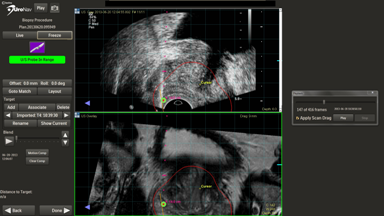June 29, 2015 - Magnetic resonance imaging-ultrasound (MRI–US) fusion targeted biopsies detect more clinically significant cancers compared with standard biopsy techniques, according to a systematic review of PubMed/Medline, Embase (via Ovid), and Cochrane Review databases.1
Researchers compared the detection rate of clinically significant prostate cancer with software-based MRI-US fusion targeted biopsy against standard biopsy. A software-based MRI-US fusion targeted biopsy approach has been proposed as a way to increase the accuracy of this diagnostic pathway. They designed a study using two strategies that theycompared in terms of detection of all cancers, sampling utility and efficiency, and rate of serious adverse events.
Fourteen papers reporting the outcomes of 15 studies , they found that MRI-US fusion targeted biopsies detect more clinically significant cancers (median: 33.3% vs 23.6%; range: 13.2–50% vs 4.8–52%) using fewer cores (median: 9.2 vs 37.1) compared with standard biopsy techniques, respectively. Some studies showed a lower detection rate of all cancer (median: 50.5% vs 43.4%; range: 23.7–82.1% vs 14.3–59%). MRI-US fusion targeted biopsy was able to detect some clinically significant cancers that would have been missed by using only standard biopsy (median: 9.1%; range: 5–16.2%). It was not possible to determine which of the two biopsy approaches led most to serious adverse events because standard and targeted biopsies were performed in the same session. Software-based MRI-US fusion targeted biopsy detected more clinically significant disease than visual targeted biopsy in the only study reporting on this outcome (20.3% vs 15.1%).

Source: UroNav composite scan of the prostate to guide precision biopsy. The image outlined in green is an MRI fused with the image from an ultrasound.
The researchers concluded that software-based MRI-US fusion targeted biopsy seemed to detect more clinically significant cancers deploying fewer cores than standard biopsy. Because there was significant study heterogeneity in patient inclusion, definition of significant cancer, and the protocol used to conduct the standard biopsy, these findings need to be confirmed by further large multicentre validating studies.
1. Valerio M, Donaldson I, Emberton M, et al. Detection of Clinically Significant Prostate Cancer Using Magnetic Resonance Imaging–Ultrasound Fusion Targeted Biopsy: A Systematic Review European Urology, Volume 68 Issue 1, July 2015, Pages 8-19. Published online: 01 July 2015.




